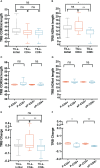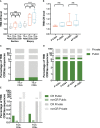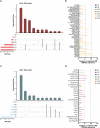Analysis of tumor infiltrating CD4+ and CD8+ CDR3 sequences reveals shared features putatively associated to the anti-tumor immune response
- PMID: 37600765
- PMCID: PMC10436466
- DOI: 10.3389/fimmu.2023.1227766
Analysis of tumor infiltrating CD4+ and CD8+ CDR3 sequences reveals shared features putatively associated to the anti-tumor immune response
Abstract
Introduction: Tumor-infiltrating lymphocytes (TILs) have predictive and prognostic value in breast cancer (BC) and exert a protective function against tumor growth, indicating that it is susceptible to treatment using adoptive cell transfer of TILs or T cell receptor (TCR)-based therapies. TCR can be used to identify naturally tumor-reactive T cells, but little is known about the differences in the TCR repertoires of CD4+ and CD8+ TILs.
Methods: TCR high-throughput sequencing was performed using TILs derived from the initial cultures of 11 BC biopsies and expanded and sorted CD4+ and CD8+ TILs as well as using PBMCs from healthy donors expanded and sorted using the same methodology.
Results: Physicochemical TCR differences between T cell subsets were observed, as CD4+ TILs presented larger N(D)Nnt TRB sequences and with a higher usage of positively charged residues, although only the latest was also observed in peripheral T cells from healthy individuals. Moreover, in CD4+ TILs, a more restricted TCR repertoire with a higher abundance of similar sequences containing certain amino acid motifs was observed.
Discussion: Some differences between CD4+ and CD8+ TCRs were intrinsic to T cell subsets as can also be observed in peripheral T cells from healthy individuals, while other were only found in TILs samples and therefore may be tumor-driven. Notably, the higher similarity among CD4+ TCRs suggests a higher TCR promiscuity in this subset.
Keywords: CD4+ T cells; CD8+ T cells; T cell receptor; breast cancer; tumor-infiltrating lymphocytes.
Copyright © 2023 Aran, Lázaro, Marco, Molina, Abancó, Peg, Gión, Garrigós, Pérez-García, Cortés and Martí.
Conflict of interest statement
The authors declare that the research was conducted in the absence of any commercial or financial relationships that could be construed as a potential conflict of interest.
Figures







Similar articles
-
Expansion of Tumor-reactive T Cells From Patients With Pancreatic Cancer.J Immunother. 2016 Feb-Mar;39(2):81-9. doi: 10.1097/CJI.0000000000000111. J Immunother. 2016. PMID: 26849077
-
Relationship between T cell receptor clonotype and PD-1 expression of tumor-infiltrating lymphocytes in colorectal cancer.Eur J Immunol. 2020 Oct;50(10):1580-1590. doi: 10.1002/eji.201948399. Epub 2020 Jun 3. Eur J Immunol. 2020. PMID: 32441316
-
T cell receptor repertoires of ex vivo-expanded tumor-infiltrating lymphocytes from breast cancer patients.Immunol Res. 2020 Oct;68(5):233-245. doi: 10.1007/s12026-020-09150-8. Epub 2020 Aug 28. Immunol Res. 2020. PMID: 32886262
-
Targeting tumor microenvironment using tumor-infiltrating lymphocytes as therapeutics against tumorigenesis.Immunol Res. 2023 Aug;71(4):588-599. doi: 10.1007/s12026-023-09376-2. Epub 2023 Apr 1. Immunol Res. 2023. PMID: 37004645 Review.
-
Why responses to immune checkpoint inhibitors are heterogeneous in head and neck cancers: Contributions from tumor-intrinsic and host-intrinsic factors.Front Oncol. 2022 Oct 18;12:995434. doi: 10.3389/fonc.2022.995434. eCollection 2022. Front Oncol. 2022. PMID: 36330485 Free PMC article. Review.
Cited by
-
Genetically predicted Caspase 8 levels mediates the causal association between CD4+ T cell and breast cancer.Front Immunol. 2024 Sep 26;15:1410994. doi: 10.3389/fimmu.2024.1410994. eCollection 2024. Front Immunol. 2024. PMID: 39391306 Free PMC article.
-
Similar usage of T-cell receptor β-chain between tumor and adjacent normal tissue in hepatocellular carcinoma.Cancer Med. 2024 Aug;13(16):e70121. doi: 10.1002/cam4.70121. Cancer Med. 2024. PMID: 39192502 Free PMC article.
-
LINC00892 as a Prognostic Biomarker in Lung Adenocarcinoma: Role in Immune Infiltration and EMT Suppression.J Immunol Res. 2025 Apr 22;2025:4341348. doi: 10.1155/jimr/4341348. eCollection 2025. J Immunol Res. 2025. PMID: 40308809 Free PMC article.
-
Local Enrichment with Convergence of Enriched T-Cell Clones Are Hallmarks of Effective Peptide Vaccination against B16 Melanoma.Vaccines (Basel). 2024 Mar 22;12(4):345. doi: 10.3390/vaccines12040345. Vaccines (Basel). 2024. PMID: 38675728 Free PMC article.
References
Publication types
MeSH terms
LinkOut - more resources
Full Text Sources
Medical
Research Materials

